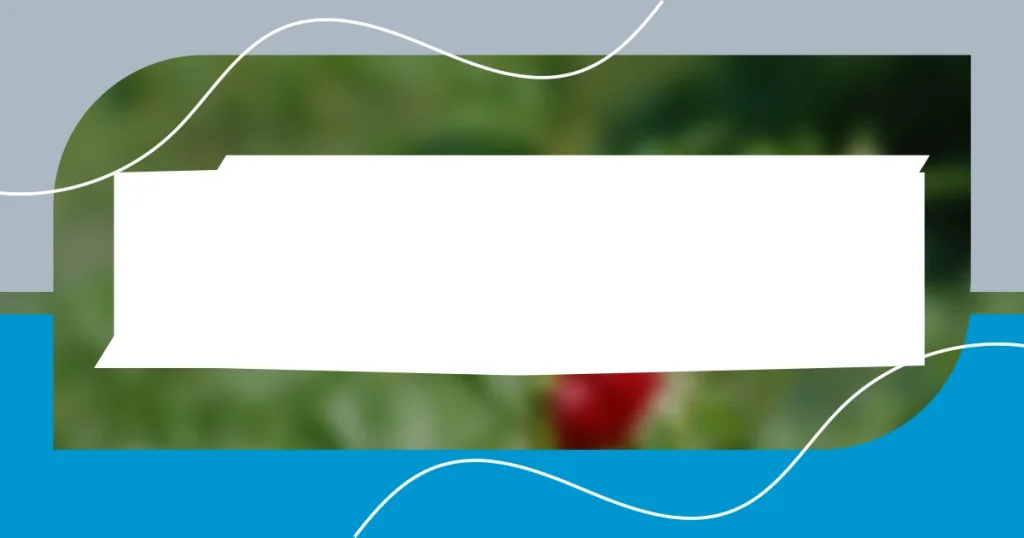Key takeaways:
- Choosing a sunny, accessible location and placing the garden near existing flora enhances pollinator attraction and ease of maintenance.
- Understanding pollinator needs, including plant preferences and blooming seasons, is crucial for creating a diverse and flourishing garden.
- Incorporating natural habitats and observing pollinators fosters a deeper connection with nature and enriches the gardening experience.

How to choose a location
When I was deciding where to place my pollinator garden, I quickly realized that sunlight was a major factor. I found that areas receiving at least six hours of direct sunlight each day yielded an abundance of vivid blossoms, attracting all sorts of delightful pollinators. Have you ever watched a bee move from flower to flower? It’s truly mesmerizing!
Another key consideration for me was accessibility. I wanted to create a space that was not only inviting for pollinators but also easy for me to maintain. Imagine being able to step outside, coffee in hand, and easily tend to your plants—the convenience of having your garden close by is immeasurable.
Lastly, consider the proximity to existing flora. I placed my garden near established flower beds, as I noticed that it acted like a natural corridor for bees and butterflies. It’s fascinating how they’ve learned where to find food sources, isn’t it? Plus, I felt a deeper sense of community with nature by seamlessly blending my garden with the existing landscape.

Understanding pollinator needs
Understanding the specific needs of pollinators is crucial to creating a thriving garden. From my experience, different species have distinct preferences. For example, while bees typically favor flowering plants that provide high nectar and pollen, butterflies often seek out host plants for laying their eggs. Knowing these preferences allowed me to curate a diverse selection of plants that cater to each pollinator’s needs.
When I first started learning about pollinators, I was surprised to discover that some species thrive in specific environmental conditions. For instance, certain bees prefer dry, warm areas, while others are drawn to more moisture-rich environments. This realization made me appreciate the importance of diversity—not just in the plants but in the microhabitats within my garden. Each pollinator seems to have its niche, and discovering those unique preferences added another layer of joy to my gardening journey.
One aspect that often gets overlooked is the blooming season of plants. Timing is everything! I’ve come to understand that having a continuous bloom from early spring to late fall ensures that there’s always food available for pollinators. There’s something truly rewarding about seeing these creatures return throughout the seasons, knowing I created a sanctuary that meets their needs year-round.
| Pollinator Type | Plant Preferences |
|---|---|
| Bees | Nectar-rich flowers, diverse species |
| Butterflies | Host plants for larvae, flat blooms for easy landing |
| Hummingbirds | Tubular flowers with high nectar |

Selecting the right plants
Selecting the right plants for a pollinator garden can feel daunting, but it can also be incredibly rewarding. I remember the first time I browsed through a local nursery, overwhelmed but excited by the plethora of options. I decided to focus on native plants because they often require less maintenance and provide the best resources for local pollinators. Connecting with the plants that thrive naturally in your area can be such a fulfilling experience; it’s like inviting nature to your backyard.
Here are some key factors that helped me in choosing the right plants:
- Native species: They adapt better and are more appealing to local pollinators.
- Diverse blooms: Selecting a mix of plants that flower at different times ensures a continuous food source.
- Plant height and structure: Including a variety of heights encourages different pollinators, as some prefer flowers at a certain level.
- Scent and color: Brightly colored flowers and fragrant blooms attract a range of species, from bees to butterflies.
- Pollinator favorites: Incorporate well-known plants like coneflowers, milkweed, and bee balm to entice a diversity of visitors.
Each time I see a new pollinator visiting my garden, I can’t help but smile. It’s a reminder of the impact we can make by simply being thoughtful about our choices.

Designing for year-round blooms
To design a garden that blooms year-round, I’ve found it essential to think ahead. Early on, I began charting which plants bloom in spring, summer, and fall. I still recall the thrill of seeing my first crocuses pop up in March, followed by the vibrant colors of echinacea and zinnias later in the year. Each bloom felt like a little celebration, reminding me that I was providing food for my buzzing friends throughout the seasons.
Balancing the timing of blooms can be a bit like orchestrating a beautiful symphony, where every plant plays its part at just the right moment. I once realized that by strategically planting a mix of early, mid, and late-season bloomers, I could create a continuous feast for pollinators. This not only keeps them happy but also brings so much life to the garden, as they drift from flower to flower, creating a lively atmosphere that truly feels alive.
On a personal note, I’ve adjusted my plans several times after noticing gaps in blooming periods. I remember planting some asters too late in the season and feeling disheartened when they didn’t bloom before the frost set in. It was a learning curve, but I now take pride in having a carefully curated list of plants that ensures beauty—and nutrition—for both myself and the pollinators, keeping my garden a vibrant resource from spring until the first snowflakes fall.

Creating habitat and nesting areas
Creating inviting habitats and nesting areas is a crucial aspect that I’ve come to appreciate deeply while designing my pollinator garden. One of my favorite features has been leaving some areas of the garden a bit wild, which may seem counterintuitive at first. I remember the moment I decided to let a corner go to seed, watching as it transformed into a haven for ground-nesting bees. Have you ever noticed how nature knows how to take care of itself when we give it the chance?
Incorporating structures like brush piles or dead wood has also proven beneficial. When I first added a small log pile, I was surprised to see how fast it became a bustling hub of activity. The excitement of observing mason bees darting in and out of the nooks and crannies was unbelievable! And it just goes to show how even the simplest additions can attract various pollinators and provide them with the shelter they need.
I’ve experimented with various materials over the years, including adding bee hotels filled with bamboo or holes drilled in wood. I didn’t expect to feel so proud watching my kids learn to identify the different nesting areas. It turned into a beautiful blend of education and connection with nature, reinforcing my belief that providing habitats is about more than just supporting pollinators; it’s about cultivating curiosity and respect for the environment. How rewarding it is to know that my garden is not only a refuge for these species but also an enriching experience for my family!

Observing and enjoying your garden
Observing my garden brings a sense of tranquility that’s hard to describe. I often find myself simply sitting on a bench, coffee in hand, watching the flutter of butterflies and the busy dance of bees. Have you ever just taken a moment to breathe in the garden’s quiet buzz? It’s in those relaxed moments that I feel most connected to nature—every buzzing sound and gentle rustle tells a story of life unfolding around me.
There’s nothing quite like witnessing a pollinator land on a flower I’ve nurtured. I remember one particularly delightful afternoon when a hummingbird hovered before me, seemingly mesmerized by the vibrant trumpet vine I’d planted. I was filled with a childlike wonder, realizing my efforts were paying off. It’s fascinating how observing these interactions fosters a deeper appreciation for the ecosystem—each pollinator plays a role, creating balance and beauty.
I often whisper thanks to the little creatures visiting my garden, and surprisingly, it feels almost like a conversation. These moments remind me that gardening isn’t just about planting and pruning; it’s about fostering connections, both to the earth and ourselves. As I see the fruits of my labor flourish around me, I can’t help but wonder: what new relationships will bloom here next, and how can I continue to invite even more life into this special corner of my world?
















